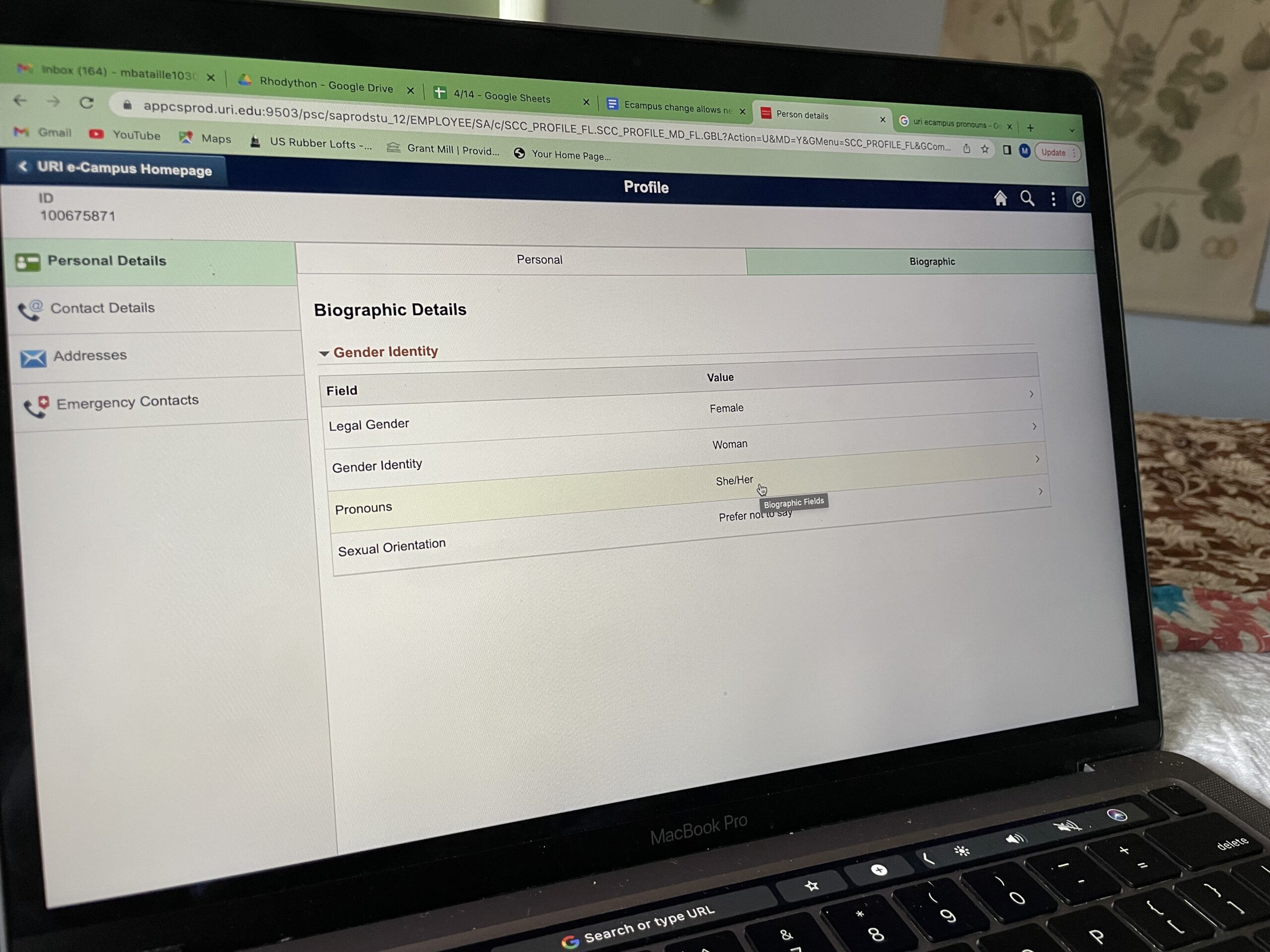New system encourages acceptance in classrooms
URI’s E-Campus page now allows students to edit their preferred name, pronouns and gender identity. PHOTO CREDIT: Maddie Bataille | Photo Editor
The University of Rhode Island released new name, pronoun and gender identity markers on most of its online systems for students, faculty and staff.
Annie Russell, director of the URI Gender and Sexuality Center, said that these changes have been talked about since around 2012, when she was listening to campus voices about adjustments they wanted to see at the University.
“One of the things that kept coming up over and over and over again was that we have no process for students, especially to be able to indicate an alternate first name,” Russell said.
Russell said at that point they created a plan with two steps, first a goal statement with the components needed in the initial phase of the process and then a vision statement with ideal plans for the future, which includes the changes being made this year.
She said the goal statement was reached in 2014 when the now outdated “preferred name process” was launched. The process allowed only students to indicate a “preferred” first name.
“It was really helpful for a lot of students and certainly started to change the campus culture a little bit,” Russell said. “But it was not ideal in terms of what we knew we wanted to do holistically eventually, because it was only open to students. It was only lab folks to do their first name. It did not allow folks to indicate pronouns or any other identity spectrums.”
Karlis Kaugars, URI’s chief information officer of Information Technology services, said that this guidance from other departments, such as the Gender and Sexuality Center and the IT Strategic Governance Committee, a group that helps the university prioritize, strategize and plan IT initiatives across the University, was essential to the technological adjustments made to PeopleSoft, the primary software application that URI uses to streamline their online processes.
“It’s really kind of cool,” Kaugars said. “This sense of community and people being able to provide their input, advice and suggestions that really move these kinds of initiatives forward.”
Kaugars said the process was lengthy because they have to be certain that the system operates properly and that the changes were implemented correctly.
“It has to go through a whole series of phases,” Kaugars said. “First, there’s a set of programming that happens, then it goes into a development environment where the other programmers test it and try it out. And then it goes into a testing environment where all the administration is free to try it out and test it to make sure it works properly and only then do we move it to production.”
He said that one of the main struggles was that PeopleSoft is a “list-based” system that requires users to choose from a set list of options, not to input their own answers.
Cougars said that in an ideal world, the application would ask open-ended questions like “what are your pronouns” so people can input whatever option they think is best, but there are software limitations that prevent that option. Instead, he asked the Gender and Sexuality Center to help decide what options would be listed in the application.
Russell said that these changes were especially important after the results of the campus climate study.
She said that the survey revealed that trans students were most likely to feel like they didn’t belong at URI and that these changes are integral to making the university more inclusive.
She said that she was grateful for the efforts put in by the IT department for their persistence to listen to her feedback.
Russell mentioned that PeopleSoft had used some outdated terms like “birth gender” and “preferred pronouns” which hold negative and invalidating connotations. The IT team spent hours coding to change those categories into the proper terms, “legal gender” and “pronouns” to ensure that all of the proper, affirming changes were made.
“We’ve sort of catapulted ourselves in front of other universities in the way that we designed this,” Russell said. “Most universities will only allow you to change your first name, some allow you to change a middle name, almost none allow you to change the last name, and we allow all three and also with the indicators for personal identity spectrums.”
Kaugars mentioned that there are still changes to be made, particularly because a lot of the University’s online systems are disconnected so changes from one application don’t necessarily translate to another.
“Every situation is a little different and a little complicated,” Kaugars said. “So what people should do is just reach out to the Help Desk service desk. Jump on and Zoom and say, ‘here’s what I’d like it to be’ and we’ll get the ball rolling for you.”
Russell emphasized Kaugars point to reach out for help, especially with changing things like usernames and emails, which are changes that have to be made outside of the PeopleSoft identify changers. These require a simple form to request the change and Russell said that not one person who submitted a request has been denied.
She said that these changes are easy and accessible today because of the determination of students.
“The reason that we even initiated any of these processes is because students told us it’s what we needed to do,” Russell said. “And my sincere hope is that it means a better life for our queer students on campus because they deserve it.”





